Comparison of percutaneous cryosurgery and surgical resection for the treatment of small hepatocellular carcinoma
- Authors:
- Zhiwei Li
- Chunhui Zhang
- Changjie Lou
- Feihu Yan
- Yinling Mao
- Xuan Hong
- Yanqiao Zhang
-
View Affiliations
Affiliations: Department of Gastrointestinal Medical Oncology, The Third Affiliated Hospital of Harbin Medical University, Harbin, Heilongjiang 150081, P.R. China
- Published online on: April 19, 2013 https://doi.org/10.3892/ol.2013.1314
-
Pages:
239-245
Metrics:
Total
Views: 0 (Spandidos Publications: | PMC Statistics:
)
Metrics:
Total PDF Downloads: 0 (Spandidos Publications: | PMC Statistics:
)
This article is mentioned in:
Abstract
The present study aimed to compare the outcome of percutaneous cryosurgery (PC) with surgical resection (SR) in the treatment of solitary, small hepatocellular carcinoma (HCC), by performing a retrospective cohort study on 82 patients with solitary HCCs who had received either PC (24 patients) or SR (58 patients). All patients underwent pretreatment blood chemistry tests and an imaging evaluation and were regularly followed up with blood and radiological tests following treatment at The Third Affiliated Hospital of Harbin Medical University, Harbin, Heilongjiang, China. The primary endpoint was overall survival (OS) and the secondary endpoints were those of recurrence‑free survival (RFS) and adverse events. In the study, the one‑, three‑ and five‑year OS rates following surgery were 100, 75.00 and 66.67%, respectively, in the PC group, and 100, 77.59 and 70.69%, respectively, in the SR group. The corresponding RFS rates at one, three and five years after PC and SR were 83.33, 45.83 and 29.17%, respectively, in the PC group and 84.48, 48.28 and 32.76%, respectively, in the SR group. There were no significant differences between these two groups in terms of OS and RFS. There were also no significant differences between the two groups in terms of OS and RFS when comparing the patients with liver cirrhosis (LC) in the PC group (n=16) and the patients with LC (n=39) in the SR group. No significant factors were identified in the multivariate analysis of the risk factors contributing to OS and RFS. Although there were no statistically significant differences between the two groups in terms of the rate of serious adverse events (P=0.82), the incidence of serious adverse events in the SR group was noticeably higher compared with the PC group. Moreover, the duration of hospitalization in the SR group was significantly longer compared with the PC group (P<0.01). These results suggested that PC is as effective as SR in the treatment of solitary, small HCC, while being less invasive, with a shorter duration of hospitalization and a reduction in patient expenditure compared with SR. Thus, PC may be the first choice for the treatment of solitary, small HCC.
View Figures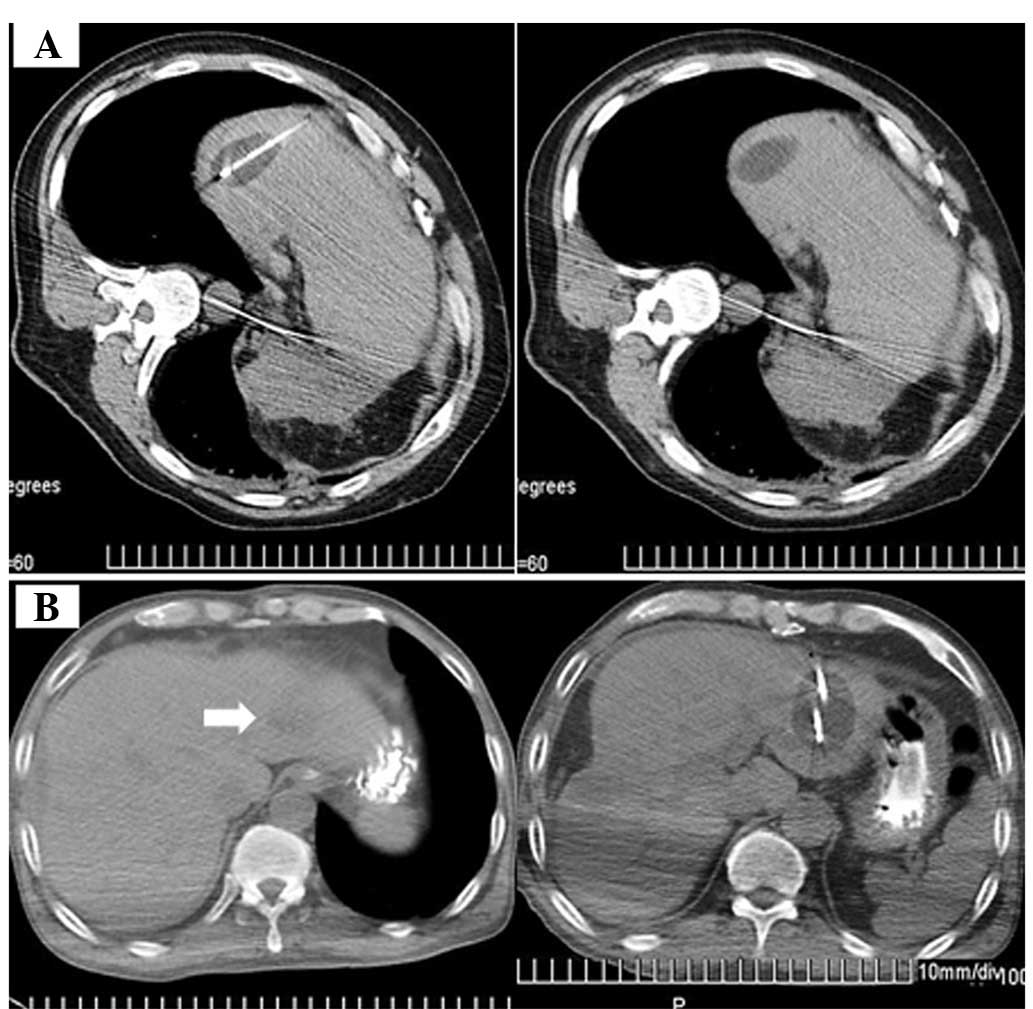 |
Figure 1
|
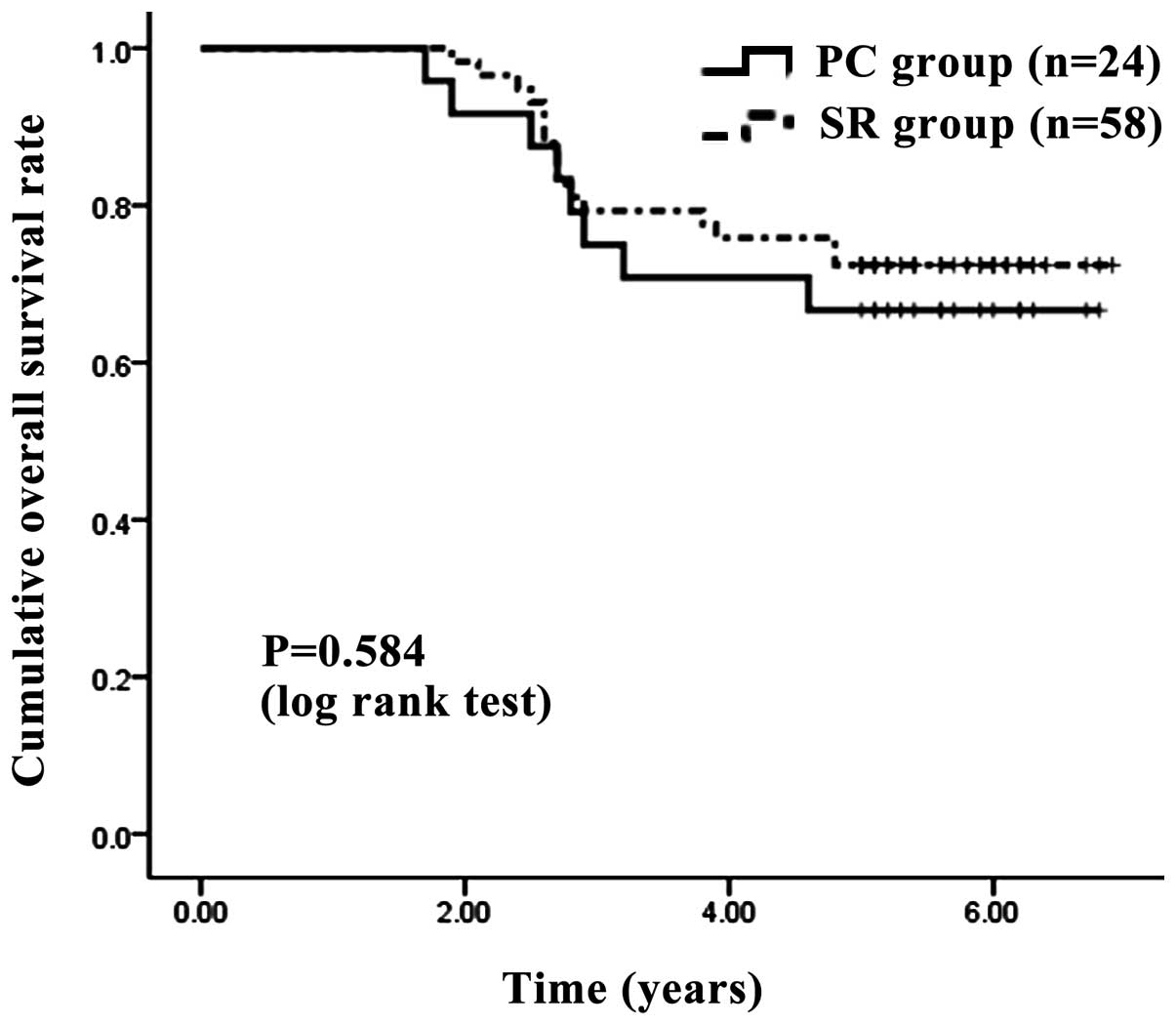 |
Figure 2
|
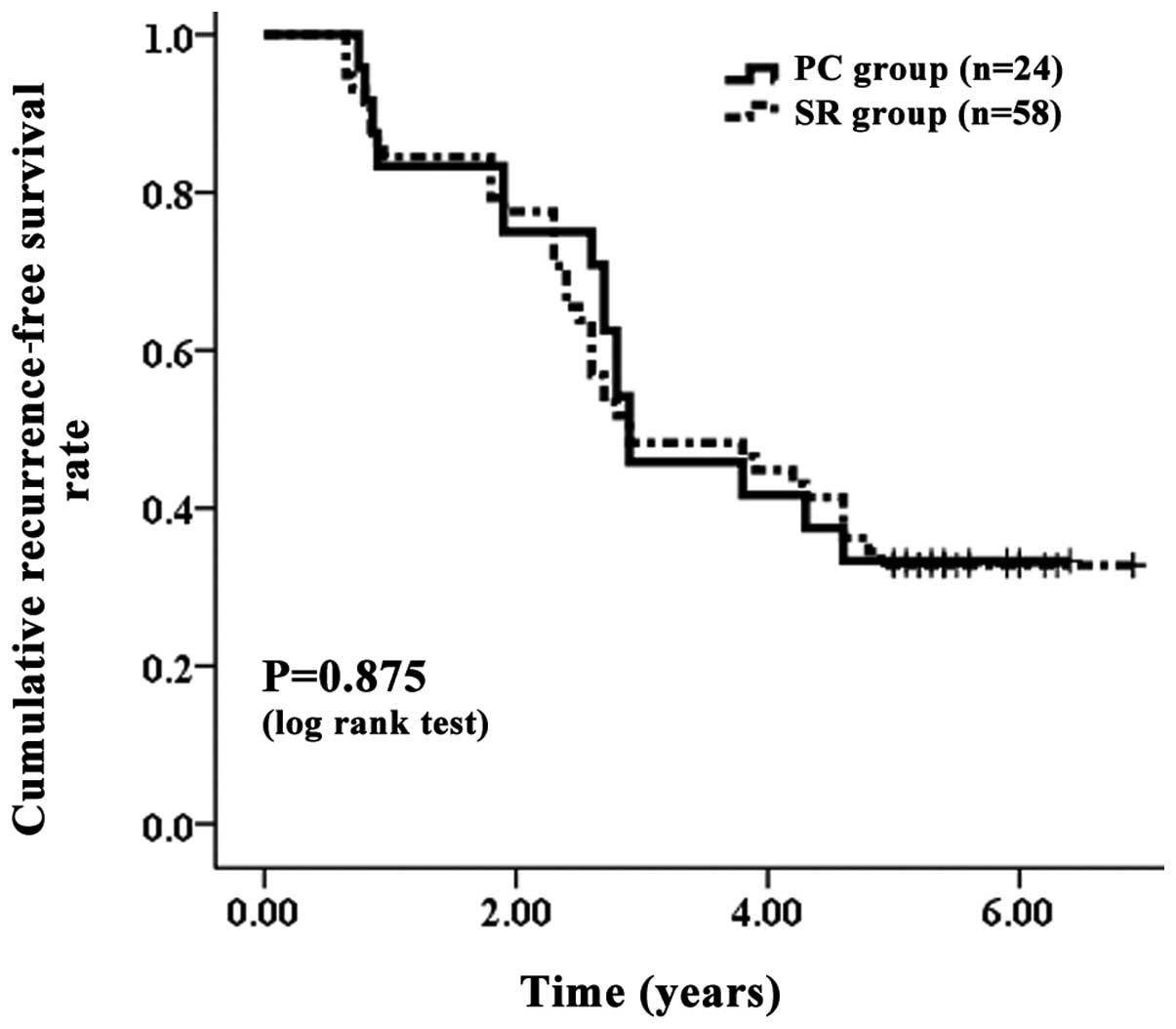 |
Figure 3
|
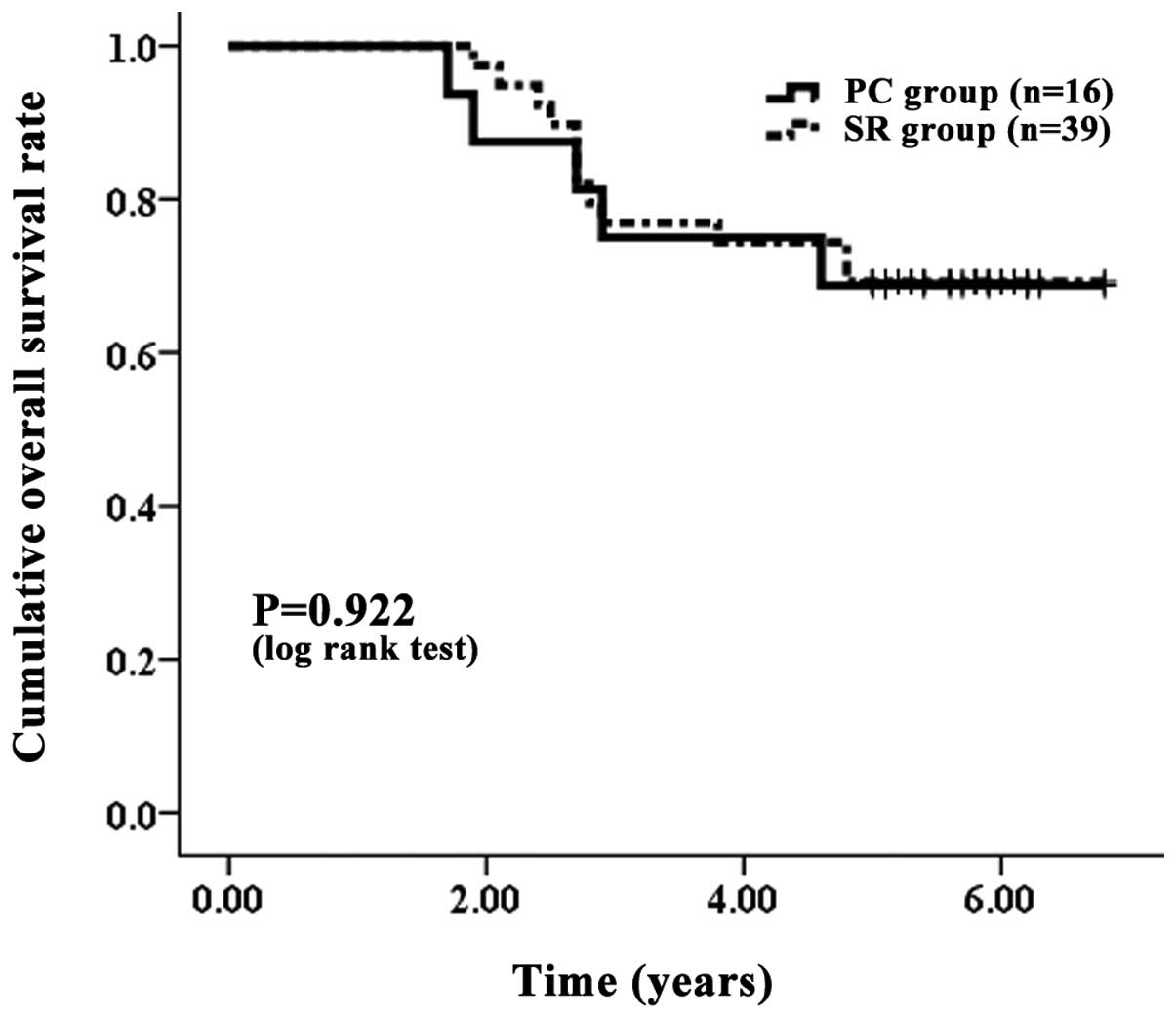 |
Figure 4
|
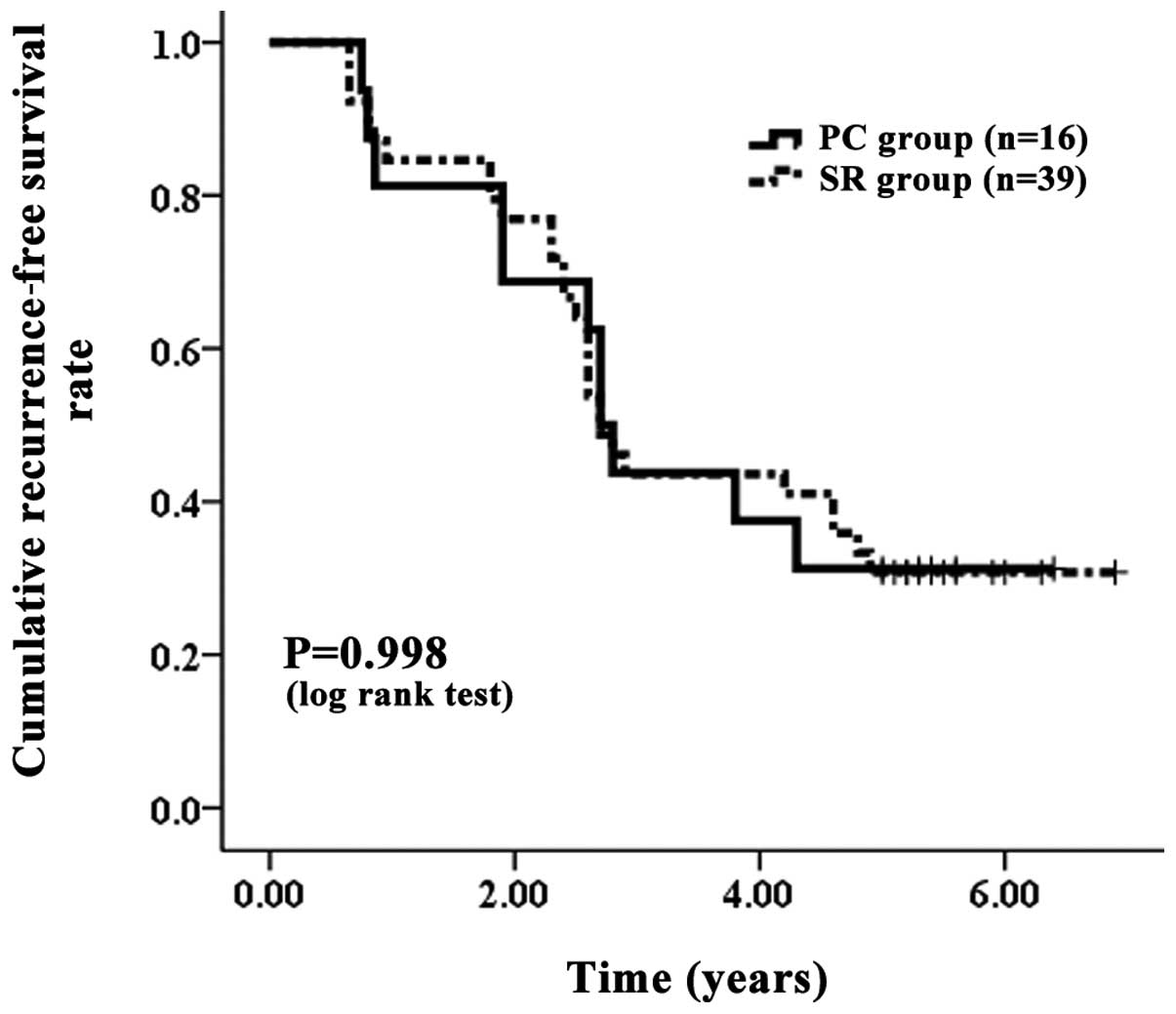 |
Figure 5
|
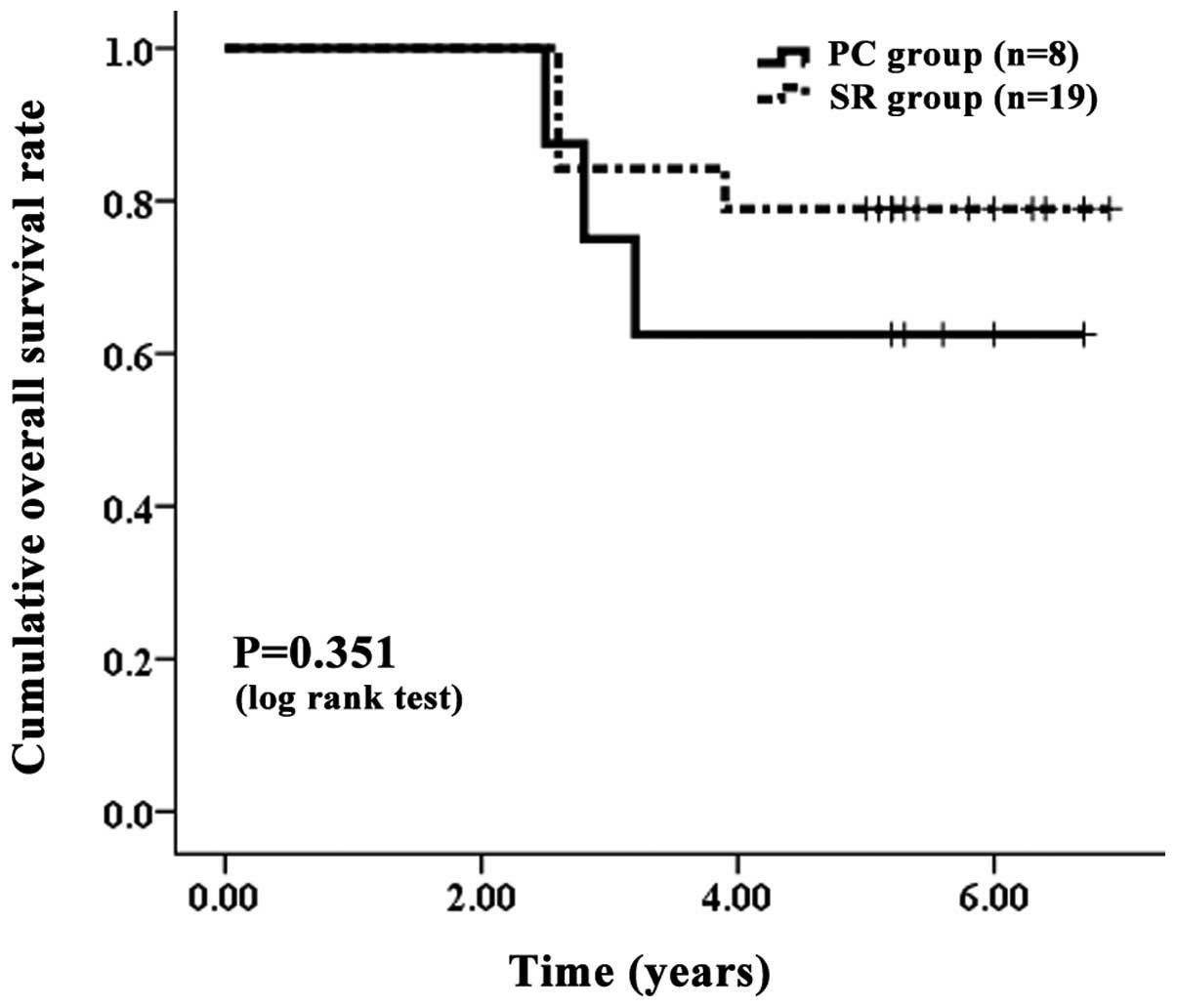 |
Figure 6
|
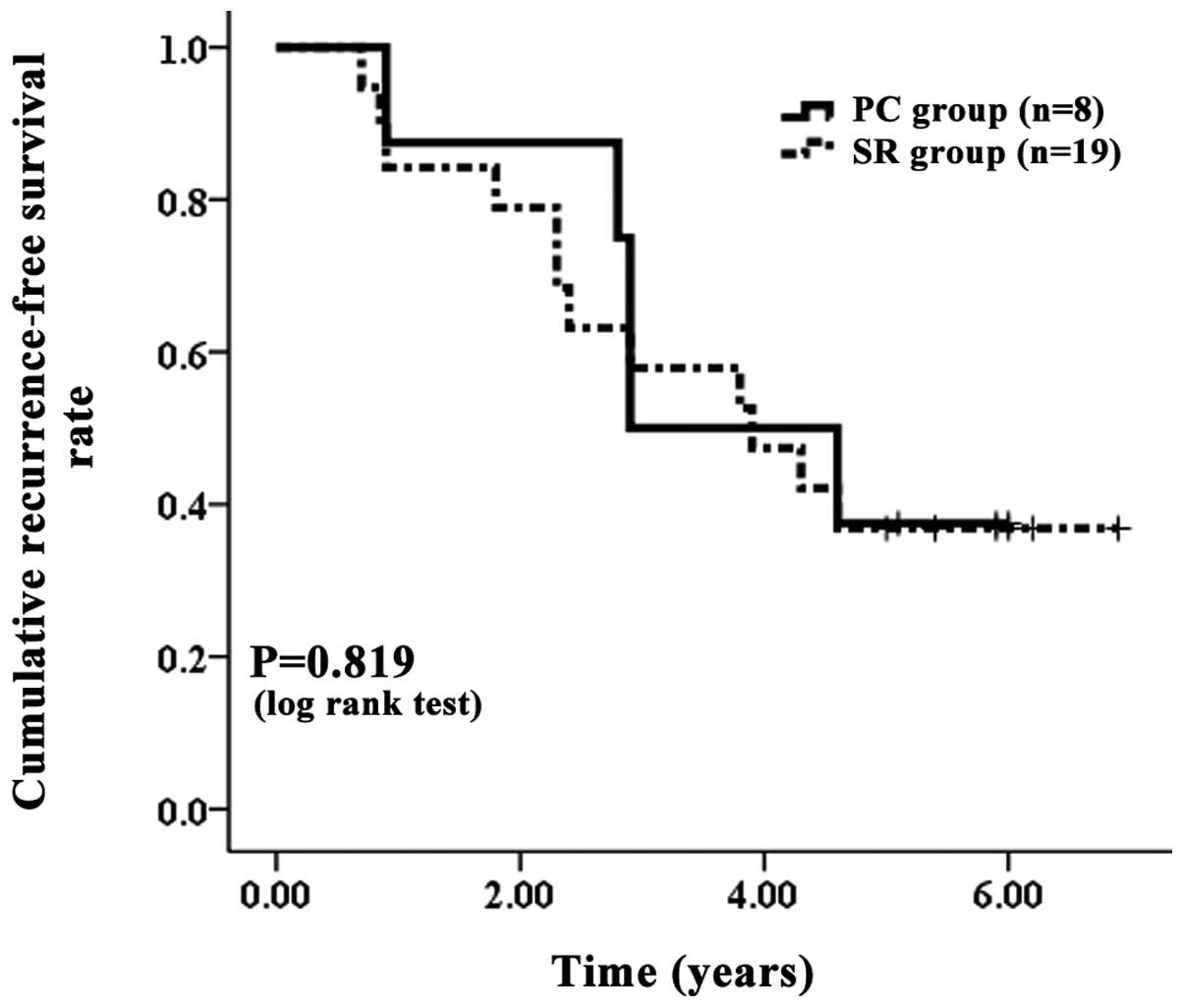 |
Figure 7
|
View References
|
1.
|
Amarapurkar D, Han KH, Chan HL and Ueno Y;
Asia-Pacific Working Party on Prevention of Hepatocellular
Carcinoma: Application of surveillance programs for hepatocellular
carcinoma in the Asia-Pacific region. J Gastroenterol Hepatol.
24:955–961. 2009. View Article : Google Scholar : PubMed/NCBI
|
|
2.
|
Bruix J and Sherman M; Practice Guidelines
Committee, American Association for the Study of Liver Diseases:
Management of hepatocellular carcinoma. Hepatology. 42:1208–1236.
2005. View Article : Google Scholar
|
|
3.
|
Yuen MF, Hou JL and Chutaputti A;
Asia-Pacific Working Party on Prevention of Hepatocellular
Carcinoma: Hepatocellular carcinoma in the Asia-Pacific region. J
Gastroenterol Hepatol. 24:346–353. 2009. View Article : Google Scholar : PubMed/NCBI
|
|
4.
|
Llovet JM and Bruix J: Novel advancements
in the management of hepatocellular carcinoma in 2008. J Hepatol.
48(Suppl 1): S20–S37. 2008. View Article : Google Scholar : PubMed/NCBI
|
|
5.
|
Duffy JP, Haitt JR and Busuttil RW:
Surgical resection of hepatocellular carcinoma. Cancer J.
14:100–110. 2008. View Article : Google Scholar : PubMed/NCBI
|
|
6.
|
No authors listed:. Liver Cancer Study
Group of Japan: Primary liver cancers in Japan. Cancer.
45:2663–2669. 1980. View Article : Google Scholar : PubMed/NCBI
|
|
7.
|
Lai EC, Fan ST, Lo CM, Chu KM, Liu CL and
Wong J: Hepatic resection for hepatocellular carcinoma. An audit of
343 patients. Ann Surg. 221:291–298. 1995. View Article : Google Scholar : PubMed/NCBI
|
|
8.
|
Nishikawa H, Inuzuka T, Takeda H, Nakajima
J, Matsuda F, Sakamoto A, Henmi S, Hatamaru K, Ishikawa T, Saito S,
Nasu A, Kita R, Kimura T, Arimoto A and Osaki Y: Comparison of
percutaneous radiofrequency thermal ablation and surgical resection
for small hepatocellular carcinoma. BMC Gastroenterol. 11:1432011.
View Article : Google Scholar : PubMed/NCBI
|
|
9.
|
Orlacchio A, Bazzocchi G, Pastorelli D,
Bolacchi F, Angelico M, Almerighi C, Masala S and Simonetti G:
Percutaneous cryoablation of small hepatocellular carcinoma with US
guidance and CT monitoring: initial experience. Cardiovasc
Intervent Radiol. 31:587–594. 2008. View Article : Google Scholar : PubMed/NCBI
|
|
10.
|
Shimizu T, Sakuhara Y, Abo D, Hasegawa Y,
Kodama Y, Endo H, Shirato H and Miyasaka K: Outcome of MR-guided
percutaneous cryoablation for hepatocellular carcinoma. J
Hepatobiliary Pancreat Surg. 16:816–823. 2009. View Article : Google Scholar : PubMed/NCBI
|
|
11.
|
Bruix J and Sherman M; Practice Guidelines
Committee, American Association for the Study of Liver Diseases:
Management of hepatocellular carcinoma. Hepatology. 42:1208–1236.
2005. View Article : Google Scholar
|
|
12.
|
Forner A, Llovet JM and Bruix J:
Hepatocellular carcinoma. Lancet. 31:379. 1245–1255. 2012.
View Article : Google Scholar
|
|
13.
|
Chen MS, Li JQ, Zheng Y, Guo RP, Liang HH,
Zhang YQ, Lin XJ and Lau WY: A prospective randomized trial
comparing percutaneous local ablative therapy and partial
hepatectomy for small hepatocellular carcinoma. Ann Surg.
243:321–328. 2006. View Article : Google Scholar
|
|
14.
|
Grazi GL, Ercolani G, Pierangeli F, Del
Gaudio M, Cescon M, Cavallari A and Mazziotti A: Improved results
of liver resection for hepatocellular carcinoma on cirrhosis give
the procedure added value. Ann Surg. 234:71–78. 2001. View Article : Google Scholar : PubMed/NCBI
|
|
15.
|
Rahbari NN, Mehrabi A, Mollberg NM, Müller
SA, Koch M, Büchler MW and Weitz J: Hepatocellular carcinoma:
Current management and perspectives for the future. Ann Surg.
253:453–469. 2011. View Article : Google Scholar : PubMed/NCBI
|
|
16.
|
Kerkar S, Carlin AM, Sohn RL, Steffes C,
Tyburski J, Littrup P and Weaver D: Long-term follow up and
prognostic factors for cryotherapy of malignant liver tumors.
Surgery. 136:770–779. 2004. View Article : Google Scholar : PubMed/NCBI
|
|
17.
|
Souna BS, Belot N, Duval H, Langlais F and
Thomazeau H: No recurrences in selected patients after curettage
with cryotherapy for grade I chondrosarcomas. Clin Orthop Relat
Res. 468:1956–1962. 2010. View Article : Google Scholar : PubMed/NCBI
|

















